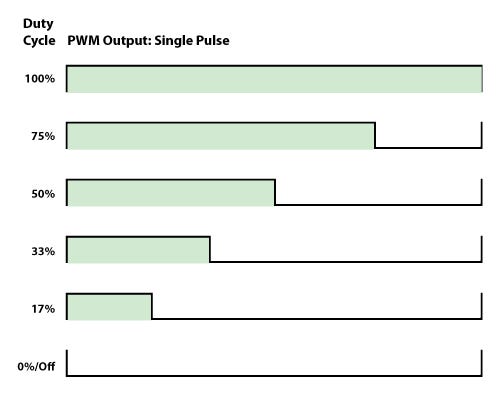Pulse Width Modulation
What is Pulse Width Modulation (PWM) and when is it used?
Our LED circuits at Environmental Lights are designed to operate at a constant voltage; Typically 5, 12 or 24 volts DC. For this reason, to dim our lights, we cannot simply reduce the voltage or the current flowing through to them. We use a Pulse Width Modulation (PWM) to dim our products. PWM is a very common method of dimming LED lights that works by very rapidly turning them on and off (pulsing) for periods that visually appear as a steady dimmed light. We adjust the brightness level by adjusting the percentage of the time the lights are on (100%) to the time they are off (0%).
What is duty cycle? Hertz?
Duty cycle refers to the percentage of the period that the light is on. As you dim the light the duty cycle (and power consumption) will decrease. At full brightness the duty cycle will be 100%. Hertz is a unit here equivalent to periods per second.
How is PWM measured? Where can I found output PWM frequency information?
PWM frequency is measured using an oscilloscope to view the period length. Each controller is tested in our lab for accurate results. This information is posted under the “Specifications” heading or can be found in the manual under the, “Documentation” heading for the particular controller on our website.
What is a good PWM?
There is no single answer to this question. It all depends on preference and the end use of the lighting. Generally speaking, the human eye does not see an appearance of flicker in lighting with PWM frequency above 60-80 hertz.
If that’s true, then why does Environmental Lights sell controllers with such high PWM frequencies?
Cameras tend to pick up on PWM flicker at much higher frequencies than the human eye. Still shots occasionally show distortions of lighting with PWM frequency of up to several hundred hertz. Digital viewfinders may also output flicker, making it hard for the photographer to focus a shot.
Video cameras, especially those used in professional studios, can pick up on flicker at much higher frequencies than normal cameras. For this reason, Environmental Lights has developed the Studio Line. All controllers in this line have a PWM frequency between 5,000 and 30,000 hertz, or they use a scrambled PWM (see Scrambled Pulse Width Modulation) of 2,000 hertz.


























